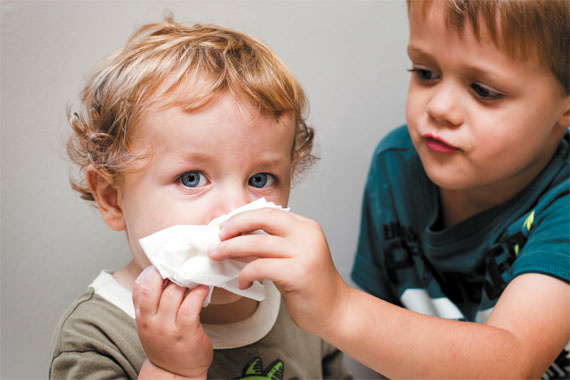roup is a common pediatric respiratory condition characterized by a barky cough, hoarseness, and occasionally stridor. Croup is most commonly seen between six months and six years of age, but can at times be seen outside of these age groups.
Boys are more frequently diagnosed than girls, but the condition is seen in both sexes. It accounts for 15% of ER and clinic visits for pediatric respiratory tract infections.
Croup can be seen at any time of year, but is most common in late fall and early winter.

We will discuss the underlying causes, general signs and symptoms, typical course, diagnosis, and treatment options for croup.
Viruses tend to cause the vast majority of infectious croup. A set of viruses called Parainfluenza viruses are responsible for most cases. Other viruses that can lead to croup include RSV, Adenovirus, Enterovirus, Rhinovirus, Echovirus, Metapneumovirus, and Influenza A and B. Bacterial causes of croup are much less common, but have been occasionally seen with Mycoplasma pneumonia and Diptheria. Spasmodic croup may be a non-infectious variant of typical croup. It has similar symptoms to croup but generally presents with less rhinorrhea and congestion (“cold” symptoms).
Spasmodic croup may be recurrent and may have an allergic component as its underlying cause.
The various causes of croup typically lead to inflammation and swelling in the upper airway. The narrowing of the airway leads to the characteristic “seal-like” cough and turbulent air flow causing stridor. In some cases this can lead to the child having difficulty with maintaining adequate oxygenation and ventilation. Children with a previously narrowed upper airway or previous history of severe croup are more likely to develop severe croup symptoms and respiratory difficulties.
Infectious croup typically starts with upper respiratory tract symptoms including rhinorrhea and low grade fevers. A barky cough and stridor may then develop.
Stridor is an audible harsh high pitched sound that may be heard when the child is breathing in (inspiration), breathing out (expiration), or during both phases of breathing. In more severe cases of croup, other signs of respiratory distress may also develop. These respiratory distress signs include rapid breathing, grunting, flaring of the nostrils, and retractions. Retractions occur when the skin areas between the ribs, below the ribs, and in the neck region, sink in with each attempt to inhale. Croup
symptoms frequently worsen at night and with agitation of the child. It is estimated that approximately 1-8% of croup episodes presenting to the ER require hospital admission.
The onset of a barky cough and hoarseness with or without stridor should warrant an evaluation by a health care provider.


Most croup is diagnosed by taking a good history and doing a careful physical exam. Laboratory studies and radiological imaging are not necessary for the diagnosis of croup in most cases. These studies, however, can be helpful if the diagnosis is uncertain or if the provider is trying to rule out other possible causes of the child’s symptoms.
Treatment of croup varies depending on the severity of the symptoms. In general, minimizing agitation and allowing the child to sit in a position of comfort are helpful.
Cool mist and humidified air have been mainstays of treatment for croup. Recent medical studies have questioned the overall effectiveness of these two interventions.
Despite this, many health care professionals still recommend the use of cool mist and humidified air. Steroids (oral or injection) and nebulized Racemic Epinephrine are also used to treat this condition.
Croup is a common pediatric respiratory condition most frequently occurring secondary to an underlying viral infection. Most cases of croup do not require hospitalization.
It is important, however, that you have your child evaluated if you suspect that he or she is developing this condition.


